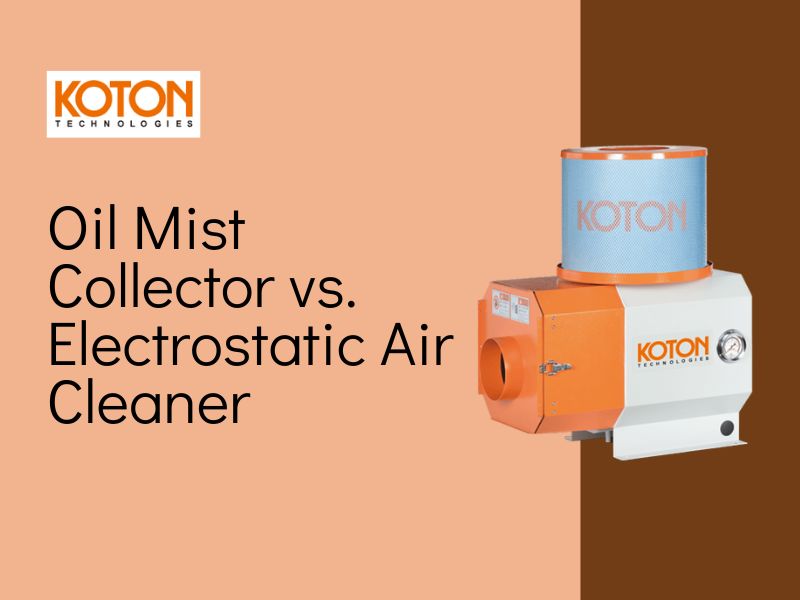Oil Mist Collector vs. Electrostatic Air Cleaner: Which Is Better for Industrial Air Purification?
2025 / 04 / 16
Introduction
In modern industrial settings, managing airborne contaminants like oil mist, smoke, and fine particulates is critical for protecting employee health, improving air quality, and extending machine life. Two of the most commonly used solutions are oil mist collectors with HEPA filters and electrostatic air cleaners. But which one is right for your facility?
This article compares these two technologies in terms of filtration efficiency, maintenance, cost, and application suitability to help you make an informed decision.
1. Filtration Method and Efficiency
- Oil Mist Collector (HEPA Filter Type)
KOTON's oil mist collectors use a multi-stage filtration system, typically including a pre-filter, main filter, and high-efficiency HEPA (EU-H11 or higher) final filter. These filters can trap up to 99.97% of particles down to 0.3 microns, including oil mist, dust, and smoke.
- Electrostatic Air Cleaner
Electrostatic air cleaners use a high-voltage electric field to charge airborne particles, which are then attracted to and captured by oppositely charged collector plates. While efficient at capturing smoke and fine particles, performance may vary depending on humidity and particle type.
✔Verdict:
HEPA-equipped oil mist collectors typically provide more consistent filtration across a wider range of particle types and environmental conditions.
2. Maintenance Requirements
- Oil Mist Collector (HEPA Type)
Maintenance involves regular replacement of filter cartridges, depending on usage and pollutant load. Though there is a cost for filter replacement, the system is straightforward and reliable.
- Electrostatic Air Cleaner
While these units do not require filter replacement, they need frequent cleaning of collection plates to maintain efficiency. Neglected cleaning can significantly reduce performance and even pose safety issues due to electrical buildup.
✔Verdict:
If routine filter replacement is acceptable, oil mist collectors offer lower daily upkeep. Electrostatic systems require more hands-on cleaning and monitoring.
3. Suitability for Oil Mist and Industrial Use
- Oil Mist Collector (HEPA Type)
Specifically engineered for metalworking, CNC machining, and grinding applications, HEPA-based oil mist collectors are ideal for capturing high concentrations of oil mist and coolant fumes directly at the source.
- Electrostatic Air Cleaner
More commonly used in HVAC systems, kitchens, or low-to-medium particle environments, electrostatic units are not as effective when handling thick, sticky oil mist, which may clog or coat the collector plates.
✔Verdict:
For oil-heavy applications, HEPA-based oil mist collectors are the preferred choice due to better handling of oily pollutants.
4. Operating Costs
- Oil Mist Collector
Operating costs include energy usage and filter replacement. However, many models, including KOTON's, are energy-efficient and use long-life filters, reducing total cost over time.
- Electrostatic Air Cleaner
With no consumable filters, electrostatic units may appear more cost-effective. However, the labor costs for frequent manual cleaning, plus possible downtimes, should be considered.
✔Verdict:
Oil mist collectors may have a higher upfront maintenance cost, but offer more predictable and efficient long-term operation.
5. Air Quality and Compliance
- Oil Mist Collector
Delivers clean, breathable air that meets strict indoor air quality and worker safety standards—especially when using HEPA filters rated EU-H11 and above.
- Electrostatic Air Cleaner
Effective in general applications but may not meet regulatory standards in industries with strict exposure limits (e.g., ISO, OSHA) without additional filtration stages.
✔Verdict:
For factories seeking compliance with air quality regulations, oil mist collectors with HEPA filtration provide a more certifiable solution.
KOTON's Product Advantages in Oil Mist Filtration
At KOTON, we specialize in developing advanced air purification solutions tailored for modern industrial environments. Our Oil Mist Air Cleaner series is engineered for efficiency, durability, and intelligent operation, making it the ideal choice for demanding applications such as CNC machining, turning, milling, and grinding.
Key product advantages include:
- Multi-stage filtration with HEPA EU-H11 filters, capable of capturing up to 99.97% of particles as small as 0.3 microns—including oil mist, smoke, and fine dust.
- Visual monitoring with smart LED indicators, helping operators easily identify when filter maintenance is required, ensuring consistent performance.
- Modular design flexibility, allowing easy upgrades with optional carbon filters or customized configurations based on pollutant types and industry requirements.
- Smart-enabled models like the T Series and W Series, which offer real-time system feedback or cloud-based monitoring to support data-driven air quality management.
KOTON's oil mist collectors are trusted by manufacturers worldwide for their long-term reliability, easy maintenance, and exceptional filtration results—even in demanding machining environments.
Conclusion
Both oil mist collectors and electrostatic air cleaners have their merits—but if your industrial facility involves heavy oil mist, coolant fumes, or high-performance machining, then oil mist collectors with HEPA filters, like those from KOTON, offer the best combination of efficiency, safety, and reliability.
Need help choosing the right air purification system? Contact KOTON today to explore our full range of Oil Mist Air Cleaners designed for your industry.

